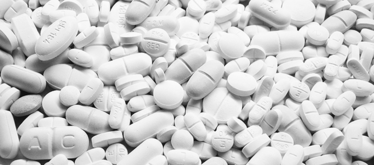A Soluble Solution for Drug Delivery
Could an ionic liquid–drug system help solve drug insolubility?

For a drug to work it must readily dissolve in the body, but that’s easier said than done. Poor solubility is a common issue in drug development. How can this be overcome? A team of scientists led by Valentine Ananikov, Professor at the Institute of Organic Chemistry, Russian Academy of Sciences, believe that ionic liquids (ILs) could be the way forward. Using salicylic acid as a model drug, the researchers fused it with an ionic liquid (1). The drug retained its activity in the IL form, but dissolved more readily in water compared with the parent drug.
“Ionic liquids consist of cations and anions, and there are a huge number of possible combinations of these ions within an ionic liquid, which allows for the ‘fine-tuning’ of their physical–chemical properties,” says Ksenia Egorova, a research scientist in the Ananikov Lab.
The group tried to obtain non-toxic ionic liquids by incorporating natural molecules, such as amino acids, into them. They found that the amino acid-containing ionic liquids demonstrated higher biological activity than the original imidazolium ionic liquids, motivating the researchers to look at other possible advantages of using ionic liquids in medicine. We spoke to Ananikov to learn more about the work.
What was the aim of your study?
Most drugs are solid substances, but they have to function in solutions. Solid substances tend to form several different crystal structures (polymorphs), but these can vary in their physical–chemical make up, as well as in their medicinal properties. In addition, their formation is difficult to control. The problems of drug polymorphism are widely recognized in modern pharmaceutics. We could overcome some of the difficulties by using active pharmaceutical ingredients (APIs) in a liquid form, which is why the solubilization of existing APIs is a subject of many active studies. It is known that salts of poorly soluble substances often show better solubility than the original APIs so the idea of transforming insoluble APIs into ionic liquids arose several years ago.
The main goal of our work was to examine whether APIs could retain their activity and acquire improved solubility when incorporated into ionic liquids. The present study involved a model compound (salicylic acid) in order to demonstrate proof of principle. We discovered that there are several ways to combine ionic liquids and APIs, which potentially gives us access to different drug delivery platforms.
What different types of drug delivery platforms did you investigate?
There are three ways to incorporate drugs into ionic liquids: via ionic bond (as an anion or a cation); via covalent bond; and via both ionic and covalent bonds.
We have synthesized ionic liquids containing salicylic acid (SA-IL) of all three types and studied their biological activity in cultures of human fibroblasts and colorectal adenocarcinoma cells. The most interesting and prominent finding was the retention of biological activity by salicylic acid in the ionic liquid form. Pure salicylic acid and SA-ILs demonstrated similar cytotoxic activity, implying that the mechanism of action of salicylic acid was not perturbed. However, SA-ILs possessed significantly higher water solubility than the original drug.
Could your method be applied to other drugs?
We chose salicylic acid due to its relative simplicity, availability and low cost. There is no reason why other drugs cannot be transformed into ionic liquids. Most APIs are complex molecules, and provided there is an appropriate functional group for linking the API to the existing conventional ionic liquid or for combining it with a counter-ion, then the API can become an ionic liquid.
What are the next steps?
We are planning to study ionic liquids containing anticancer drugs in an attempt to create highly active, water-soluble compounds. The numerous possible variations of the chemical structures of ionic liquids will very likely reveal valuable opportunities for target drug delivery into cancer cells.
I also hope that the API-IL concept developed in our study will encourage other researchers to develop new drug delivery platforms. Undoubtedly, the development of new drugs and strategies for treatment of various diseases is one of the most important scientific directions all over the world. To perform this task successfully, researchers must collaborate to explore new possibilities opened up by cutting edge development of modern chemistry. We are open for cooperation and we are looking forward to finding new partners!
How do you see the area of API-IL developing in drug development?
Several studies of ionic liquids bearing various drugs, such as ampicillin and ibuprofen, have been carried out, but data on the medicinal activity of API-ILs are scarce, and none have been approved for clinical trials. However, I believe that API-ILs will attract much attention in biochemistry and medicine as their advantages are explored in more detail.
In addition to practical applications, there is a challenging fundamental problem that remains: to understand spatial organization of molecules in solutions and reveal the influence of this spatial organization on living organisms.
- V. P. Ananikov et al., Cytotoxic Activity of Salicylic Acid-Containing Drug Models with Ionic and Covalent Binding, ACS Medicinal Chemistry Letters 6(11), 1099-1104 (2015). DOI: 10.1021/acsmedchemlett.5b00258

Making great scientific magazines isn’t just about delivering knowledge and high quality content; it’s also about packaging these in the right words to ensure that someone is truly inspired by a topic. My passion is ensuring that our authors’ expertise is presented as a seamless and enjoyable reading experience, whether in print, in digital or on social media. I’ve spent fourteen years writing and editing features for scientific and manufacturing publications, and in making this content engaging and accessible without sacrificing its scientific integrity. There is nothing better than a magazine with great content that feels great to read.



















